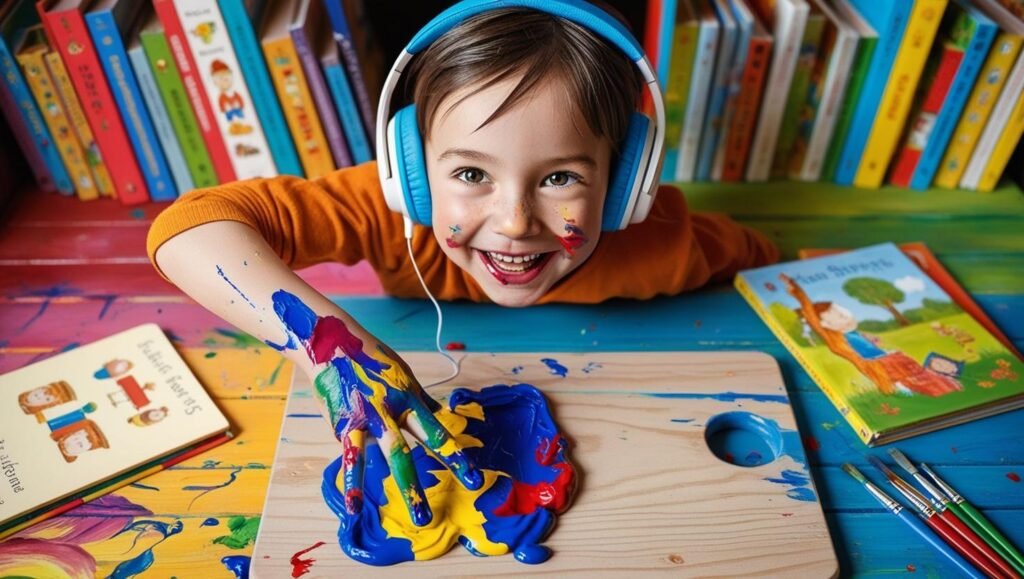
Creating, imagining, and expressing freely are essential parts of child development. That’s why providing artistic experiences from an early age is not just a form of entertainment, but a powerful path to foster cognitive, emotional, and social growth.
In this article, you will discover how to use music, art, and reading at home to stimulate children’s creativity and expression in a practical, nurturing, and accessible way.
Why Stimulate Creativity in Childhood?
Creativity is an essential life skill. Creative children grow into more confident, resilient, communicative adults with greater problem-solving abilities.
When children explore different forms of expression — like drawing, singing, painting, or inventing stories — they:
• Develop self-confidence
• Improve communication and language
• Learn to handle emotions
• Build meaningful connections with the world around them
How Art, Music, and Reading Foster Creativity
🎨 Art
Art allows children to experiment with colors, textures, shapes, and techniques. Whether it’s painting with tempera or making collages with colored paper — the key is to create freely!
Skills developed:
• Fine motor coordination
• Visual perception
• Planning and autonomy
• Imagination
🎵 Music
Listening, singing, and playing instruments enhance auditory perception, rhythm, and language development.
Skills developed:
• Rhythm and concentration
• Emotional expression
• Speech development
• Sociability
📚 Reading
Listening to stories or flipping through books expands vocabulary and world knowledge.
Skills developed:
• Imagination and empathy
• Thought organization
• Emotional bonding
• Interpretation and storytelling
9 Creative Activities with Art, Music, and Reading
🎨 1. Finger Painting
Materials: Non-toxic paint, kraft paper
How to: Offer paint and let the child paint freely with their hands. Stimulates tactile senses and expression.
🎵 2. Family Talent Show
Materials: Children’s songs, toy microphone
How to: Organize performances with dancing, singing, or playing instruments. Boosts self-esteem and body expression.
📚 3. Cozy Reading Corner
Materials: Children’s books, cushions
How to: Create a comfy space and read daily with your child. Ask questions and encourage them to create alternate endings.
🎨 4. Sculpting with Play Dough
Materials: Homemade or store-bought play dough
How to: Shape characters, animals, or objects. Enhances fine motor skills and 3D imagination.
🎵 5. Sound Toys with Recyclables
Materials: Bottles, rice, beans
How to: Make shakers and explore different sounds. Stimulates creativity and musicality.
📚 6. Illustrated Storybook
Materials: Paper, colored pencils
How to: Help your child invent and illustrate a story. Make a handmade book to keep.
🎨 7. Crayon Drawing on Sandpaper
Materials: Fine-grain sandpaper, crayons
How to: The unique texture creates a special sensory experience. Encourages curiosity and aesthetic expression.
🎵 8. Musical Guessing Game
Materials: Clips of well-known songs
How to: Play the melody and challenge your child to guess or complete it. Develops memory and attention.
📚 9. Dramatic Storytelling
Materials: Short stories
How to: Act out characters with different voices and expressions. Children can participate as narrators or characters.
How to Include These Activities in the Routine
Age Range Suggested Frequency Average Time
2-3 years Once a day 15–20 minutes
4-5 years 1–2 times a day 30 minutes
6 years Twice a day 30–45 minutes
Prefer times when the child is rested and receptive.
Golden Tips for Encouraging Creative Expression
• Don’t correct or criticize the child’s creations: value the intention and process, not just the final result.
• Join the activities: sing, paint, and read together. Interaction strengthens bonds and motivates the child.
• Allow organized mess: let the child freely explore materials under supervision and safety.
• Encourage creative independence: offer options, but let the child choose how they want to express themselves.
Conclusion
Creativity is not just a gift — it’s a skill developed through stimulation, freedom, and opportunity. Music, art, and reading are rich and loving ways to awaken children’s creative potential, especially when integrated into family life.
Make time each day to create, sing, imagine, and tell stories with your child. The rewards of this investment go far beyond childhood!
